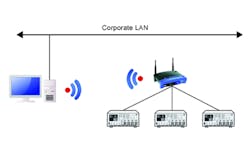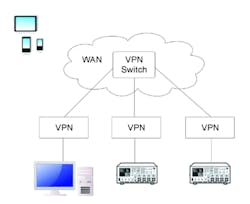Often the first thing that comes to mind when we think of cloud computing is software or software as a service. Many of us are already personally using some form of software in the cloud today such as Google’s Gmail, iCloud, or even Facebook for that matter. Then there are platform-as-a-service providers, such as Google App Engine or SalesForce.com, that support a computing platform and a solution as a service for enterprises. Seldom do we associate hardware, or more specifically, test equipment with cloud computing.
With today’s global economy, companies have their resources distributed around the world. These global engineering resources must work closely together and maximize the test instruments at their disposal throughout the design and testing life cycle of a product. One major challenge that these global engineering teams face is sharing real-time access to test instruments and the resulting test data across thousands of miles and country borders.
LXI Facilitates Cloud Computing
LXI is the standard for Ethernet control of instrumentation. The LXI Standard, developed and maintained by the LXI Consortium, is defined as a set of core features and optional extended functions. Certified LXI products have been tested and proven to conform to the LXI specification. As such, test engineers are assured that combinations of LXI instruments will integrate seamlessly with one another.
Since it is based on Ethernet, LXI enables new distributed applications. In doing so, a company’s investment in test equipment can be fully utilized from anywhere in the world at any time, and the measurement data collected can be shared in real-time across the organization. Figure 1 demonstrates one scenario where users can operate and control test instruments wirelessly from anywhere within the corporate LAN.
Figure 1. Shared Test Instruments within a Company
The LXI Standard also specifies that LXI instruments include a W3C-compliant web interface. LXI discovery tools can be used to automatically discover the LXI device on the network, or alternatively, by entering the instrument’s IP address in a web browser (Figure 2).
Figure 2. Controlling an LXI Device with its Web Interface
Users can access the instrument via its web interface from any web-enabled device including laptops, smartphones, and tablets from anywhere in the world to control an instrument, monitor and collect data, or change settings on test systems. The simplest way to use a smart device, such as an iPAD, to control the instrument is to connect via VPN to the company’s WAN.
Using Smart Devices for Test in the Cloud
Since smart devices have access to both the cellular and Wi-Fi networks, they are the ultimate ubiquitous controller for LXI instruments. However, the Internet connection to the smart device is not always guaranteed. Therefore, the use of smart devices for controlling instruments makes more sense for data-acquisition types of systems where instruments typically run on their own and just need to be accessed to start or stop a test or change a setting (Figure 3).
Figure 3. Smart Devices Accessing Test Instruments via WAN
However, since operating systems for smart devices, such as iOS or Android, do not currently support Java applications, there is some programming necessary before you can use these devices to control instruments remotely. Companies such as Agilent Technologies now provide free I/O tools that can be downloaded to help program the device.
When thinking of using cloud computing for test, you could imagine a central company running server software that is controlling test instruments from various locations around the world. While this is technically possible, it is not a very common practice. Typically, the cloud is used today to access test data remotely from anywhere using a computer or web-enabled smart device. For example, using cloud-based secure managed file transfer, it is possible to view test data from LXI instruments using an iPad at the airport or from a laptop at a café.
The video The Rise of Smart Devices and the Cloud provides more details and application examples.
Benefits of LXI and Cloud Computing
From the user perspective, the benefit of using LXI and cloud computing is obvious: LXI instruments and their measurement data can be accessed at any time and from anywhere in the world. There also are several benefits of cloud computing for companies that enable them to quickly realize a return on their investments in test and measurement instruments, including:
- Efficient use of engineering resources located in different time zones.
- Reduced fixed cost of capital investment in test equipment.
- Lower operational and maintenance costs with remote execution, monitoring, and debugging.
- Reduced computing costs with dynamic allocation of memory and processing power.
Summary
LXI facilitates the adoption of cloud computing in the test and measurement industry. The LXI standard overcomes the challenges of distributed test systems by offering remote control of test instruments from anywhere in the world at any time via a consistent web interface. An LXI distributed system allows instruments to be located closer to the measurements, reducing cable lengths and signal distortion, while simplifying and reducing costs associated with setup, monitoring, and maintenance.
About the Author
Neil Forcier is an application engineer for the System Products Division at Agilent Technologies, a founding member of the LXI Consortium. Previously, he served in the U.S. Navy as an electronic test equipment calibration technician on-board the USS Harry S Truman CVN-75. Forcier earned a bachelor’s degree in engineering from Pennsylvania State University.



